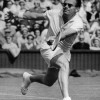Hall of Famer Jan Kodes along with Czech author Petr Kolar have put together a tremendous volume of the history of Czech tennis in the book A JOURNEY TO GLORY FROM BEHIND THE IRON CURTAIN. The hard-cover coffee-table book, available here for $39 http://www.amazon.com/Jan-Kodes-Journey-Behind-Curtain/dp/0942257685/ref=sr_1_1?ie=UTF8&s=books&qid=1287408541&sr=1-1 discusses the life and career of Kodes, the 1975 Wimbledon champion, as well as the development of Czech tennis through the years.
In this book excerpt, Kodes discusses his conversation with left-handed Czech tennis legend Jaroslav Drobny prior hip semifinal match with British left-hander Roger Taylor during his run to the Wimbledon title in 1973.
Jaroslav Drobny was a left-hander who gained much experience while traveling around various tennis facilities of the world. It was no wonder that Jan Kodes approached him before his Wimbledon semifinal match against Taylor with a question: “Jaroslav, tell me, what bothered you the most when you faced a right-hander: when he served toward forehand into your body, or into the backhand out and away to the side? He hits a low sliced crosscourt backhand to my forehand volley, and that bothers me. I have no idea where he would hit a forehand shot.”
“Jan, remember one thing above all: you must hold a left-hander nice and tight, meaning that you keep on feeding the shots into his backhand because his reach is limited on that side. In order to make it look as casual as possible make sure that as soon as you know that you can put the ball away hit it into his forehand. That way he’ll feel that you are hitting indiscriminately into both sides” said Drobny. “In the toughest moments and situations, when you are pressed only to rally, you must always target the backhand side! It is less likely that he’ll hit a passing shot from that side. Lefthanders generally pass from a running forehand and they have a hard time to do the same from their backhand.”
KODES: This was yet another time when his advice was very helpful. There was just one more thing I needed. When somebody gives you advice you are still dealing only on the theoretical level. You must be able to turn it into practice – you must remember to do so in a match! I re- membered Jaroslav during the match with Taylor about three times. During a match one cannot concentrate only on one thing but rather it is necessary to evaluate and find weapons for all kinds of situations. However, when a match reached an important point I often bounced the ball several times before serving it and resolved: If he returns into my forehand, I’ll follow Jaroslav’s instructions. If he returns a low ball I’ll volley it crosscourt. I approached the net determined to carry out that decision without altering it! It did not matter how the opponent moved or did not move; I played what I had decided and waited for the reaction.
As soon as one decides to change the strategy while already on the run, invariably you botch it! Such are the laws of the game of tennis that apply twofold on grass surface. You don’treach advantage on your opponent’s serve, perhaps twice in a set. You either break your opponent’s serve or you don’t but you won’t have another chance to do so any time soon. On clay you will, on grass you won’t. It is in these very moments that a player must play with utmost concentration and according to those unwritten tennis rules. Even if I hit the ball out it does not bother me that much since I followed my plan; I get really unhappy if I botch a ball because I did not stick to my principles.
I had about five rackets with me in Wimbledon but I wanted to use only two of them during the finals. The leather grip was already thumbed and my fingers slid in comfortably, the string tension was just right, one slightly softer. However, I ran into a problem after the morning semi-finals. Two strings in one of the rackets started to roll. That posed a dilemma: should I ask to have it re-strung? Or should I just let it be? My rackets had been strung specifically for me in Prague and I was used to them. Naturally, they strung rackets in Wimbledon too, but each machine leaves a different touch, one is set to kilograms, the other to pounds and the pound-setting did not suit me well.
I approached Drobny and asked him to look at my racket. He took off his glasses, studied the strings for a while and then he said: “Play with it! Take the risk; I don’t think it will break. On clay it would not survive a set because clay is coarse but it should last through a match on grass.” And it lasted through the entire final match!

